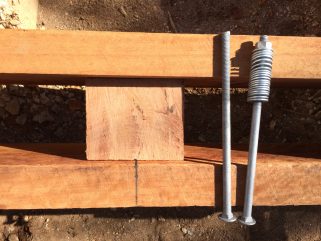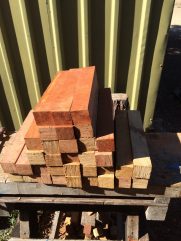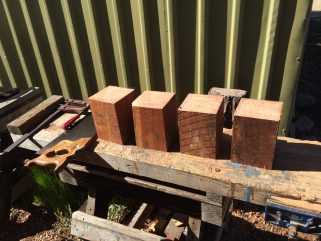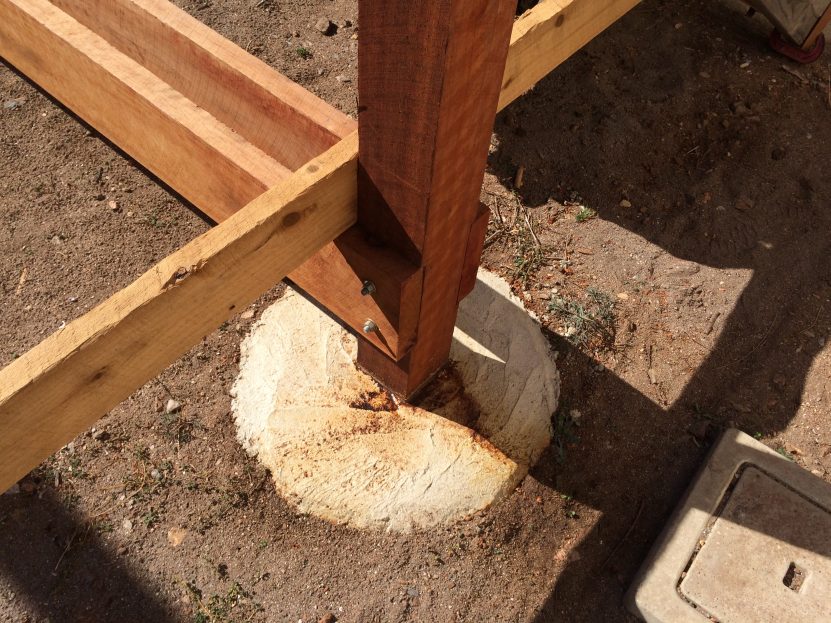DAY 5
Roland has kindly created this site, to record the construction of our Boatshed, and (possibly) subsequent boatbuilding projects. My grateful thanks to him for his generous help, and for offering it unasked. He had the vision, and the technical knowhow to make it happen.
Simon Scott has been working with me, every Friday, from the early days of construction, and will continue to be on hand until the roof is completed (next job). Simon is a man of many parts, and – fortunately for me – has a great deal of building experience and knowhow. Without his assistance, those extraordinarily heavy Ironbark posts would not be vertical.
My thanks also to fellow members of Silver Mist (SA) Pty. Ltd. for their steadfast support and encouragement over the months (and years).
This Week has seen steady, but modest progress. The photos (expertly taken by Sam, using his phone Device) tell the story, but may require some translation.
The posts, as implied above, will never again move, so I thought I might as well concrete them in, just to make sure (of course, it is specified in the plans). I have just finished the seventh hole; eight to go. I am mixing the concrete by hand – and if some of you are wondering why I am mixing concrete by hand, my best and only reply would be the one that a local shop assistant recently tried out on me: because I can.
At the time it seemed like an impressive response.
Sam has taken a photo of the Soldiers, which are made from from offcuts of Native Cypress and Ironbark. Each Soldier will be bolted vertically into a rafter, and a purlin, wherever a rafter and a purlin intersect. (Purlins are the long timbers running at right-angles to the rafters, onto which the roofing iron is fastened). The Soldiers should stop the roof coming off; I much prefer them to metal straps.
The twin bearers are Ironbark, of great weight and durability (Class 1). I am currently bolting sturdy Ironbark spacers between each double-bearer, as specified. The idea is this: if by chance our Boatshed is swept away by a hurricane, it will become airborne in one piece, and land in one piece, on its footings – and the boats inside will be undamaged.
Next job, and next Posting: the Roof.




Wonderful photos – adds a very professional touch to the whole.
Hi Chris,
All this in 5 days!! It will be finished before I have a chance to help.
This boatshed isn’t going anywhere. Besides we don’t do hurricanes in SA.
Blog is a good idea; all it needs is some photos of the blogger. 🙂
See you soon; ~ 2-3 weeks maybe. Still in Nepal.
cheers
Ian
I keep thinking of the poor termites grinding their teeth fruitlessly on those posts.
Wow Chris, that’s bigger than a spoon. Looking really good. I rather despise the rampant over use of the word “awesome” but here it applies. 🙂
Looking good Chris. Has Jon talked to you about his ‘woodshed’ down the end of our garden? Same principles apply, it’s NEVER going anywhere. Lets hope global warming doesn’t throw a spanner in the works and the boats sail away and leave the shed behind!
Cranky Pants is now demanding a similar structure for her comfort and safety as opposed to her little seaweed lined cardboard box. Serious chook envy.
But seriously, your boat shed will be an asset to the built heritage of the district.
As usual your drive for a simple and sustainable life is an example for the rest of us as is your eye for natural beauty.
A pity that you can’t take on a certain mature apprentice who needs a career change.
Congratulations to you and Simon.
I gather these are equivalent to the Days of Creation–deeply impressive–and a lot of fun. Nice seeing some of the old hand tools lying about the place.